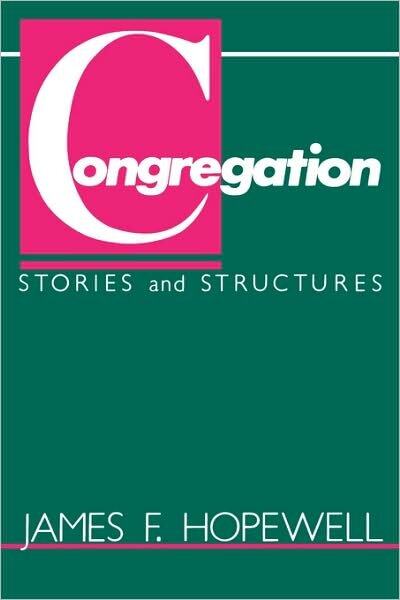James F. Hopewell, Congregation: Stories and Structures. Augsburg Fortress, 2006.
Referenced in: Congregational Culture, Church Identity
LifeandLeadership.com Summary
This remains as one of the most fascinating and unique discussions of the church since its original publication in the late 1980s. It may be still be purchased as hard copy, but the entire text may also be found online (click the hyperlinks to go to the text of each chapter).
Hopewell’s motivation was to discern the seemingly indestructible nature of some congregations, even against great odds. His examination led to a way of understanding churches through the narrative types developed by Northrop Frye – comic, romantic, tragic, and ironic. He suggests congregations tell their stories using a similar rubric, often on a sub-conscious and unspoken level unless seriously challenged. These stories represent a deeply held worldview (the appendix contains a World-View Test for leaders to help congregations assess the dominate narrative of their congregations). Below is a brief run-down of the four types as expressed in churches:
- Tragic (Canonic) – Everything will end in judgment. Legalistic. Authoritative. Obedient. You suffer, die to self. “Get right with God.” From solution to problem. Fundamentalist. “God says it. I believe it. That settles it.” “If you’re enjoying it, something is wrong, you need to repent.” Works vs. Grace. Never can be sure.
- Comic (Gnostic) – Everything will have a happy ending. Crisis to harmony. Problem to solution. “Everything will work out.” “Let go and let God.” “Go with the flow.” “Laid back.”
- Romantic (Charismatic) – Emphasis on transcendence. Captured by supernatural irregularities, God’s intervention into man’s inefficiencies. “God told me…” “God wants me to…” “We met Christ…”
- Ironic (Empiric) – Full of paradox. Everything is gray with black and white around the edges. Realistic. Confuse people with the facts. Hermeneutical agnosticism. From ideal to real. “Do not be holier than thou.”
In his research, he discovered that these narratives/world views are so powerful that members and ministers who resonate with the dominate story enjoy a more satisfying relationship with the church, and those who do not feel marginalized. The developmental value of this approach lies in helping churches discover and articulate their story to clarify identity and mission, and to thus elevate perceptions of congregational effectiveness above lesser measures such as bodies, buildings, and budgets. It also helps in determining the success of congregational interventions, as the data revealed through a consultation is not as catalytic toward change as the story the members tell themselves about the data, which again reflects narrative/worldview.
This is not an easy read, but wading through it will provide a lifetime of insight into how churches thrive. I would recommend reading chapters 4-6 first to get the gist of the book, and read more if you have interest. Again, the entire text may be found online (click the hyperlinks to go to the text of each chapter).
From the Publisher
In a unique, full-scale study of congregational life, Hopewell shows that it is narrative-the oral tradition-that knits a congregation together.
About the Author
At the time of his death in 1984, James F. Hopewell was Professor of Religion and the Church and Director of the Rollins Center for Church Ministries at the Candler School of theology, Emory University.
***For additional information on this resource, including reviews, click the bookstore links. Check the reference at page top or the links below for resource guides on related topics.***
See Other Resources on Church Leadership and Renewal:
- Church Leadership and Renewal, Index
- Church Leadership, Theological Foundations, Ecclesiology
- Church Leadership, Philosophical Foundations – e.g. Church Growth, Missional, Emergent, and Other Missionally Responsive Trajectories
- Church Leadership, Practical Foundations – Church Dynamics and Research
- Church Leadership, Practical Foundations – Congregational Culture, Church Identity
- Church Leadership, Practical Foundations – Size Dynamics, Size Transitions
- Church Leadership, Practical Foundations – Research and Case Studies on Effective Churches
- Church Leadership, Special Situations – Small Church Development
- Church Leadership, Strategies for Renewal
See Resources on Over 100 Areas of Ministry Leadership:


